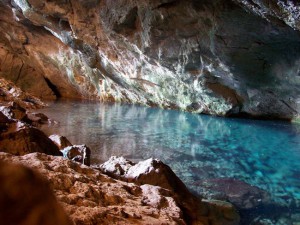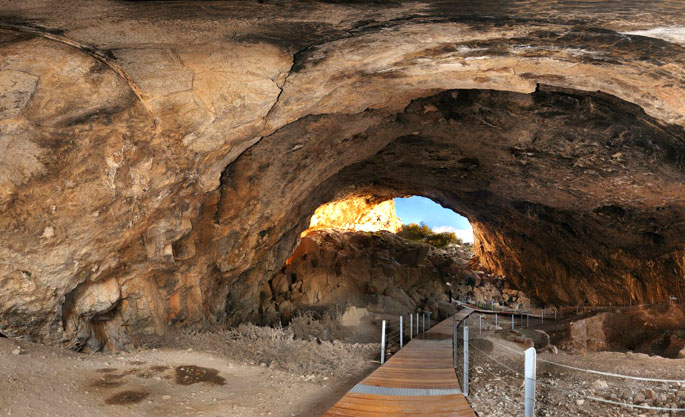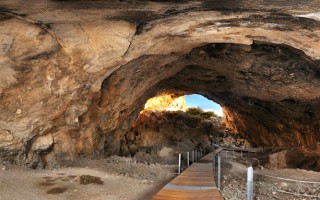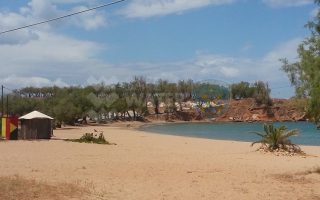Frachthi cave is a world famous monument situated at the wild rocky mountain opposite the village Koilada. Excavations brought to light numerous findings among which the oldest human skeleton attesting its continuous occupation for more than 20.000 years. Walk through the beach Lampagianna, climb to the cave and enjoy the view.
 The world famous Frachthi cave is located next to the sea, opposite Koilada village, on a rocky hill covered by shrubs. Visitors can wander in the two chambers of the cave and admire the reflecting sun rays on the small lake situated in the center of the cave. It is west oriented, at an elevation of 12.5m over sea level and in a distance of 50m from the shore. Its total depth reaches 150m. In the past, during the Stone Age the distance to the sea was larger.The cave was first inhabited by the Homo Neanderdhal during the Paleolithic age (40.000 B.C.) and it was re-occupied by homo sapiens (wise human) after 30.000B.C. There are elements illustrating its continuous occupation from 25.000 B.C. to 30.000 B.C. when it was destroyed by a big earthquake.
The world famous Frachthi cave is located next to the sea, opposite Koilada village, on a rocky hill covered by shrubs. Visitors can wander in the two chambers of the cave and admire the reflecting sun rays on the small lake situated in the center of the cave. It is west oriented, at an elevation of 12.5m over sea level and in a distance of 50m from the shore. Its total depth reaches 150m. In the past, during the Stone Age the distance to the sea was larger.The cave was first inhabited by the Homo Neanderdhal during the Paleolithic age (40.000 B.C.) and it was re-occupied by homo sapiens (wise human) after 30.000B.C. There are elements illustrating its continuous occupation from 25.000 B.C. to 30.000 B.C. when it was destroyed by a big earthquake.
Originally it was occupied by some hunters that had found refuge in it. During the Middle and Later Neolithic Age more people begun to gather. Sediments that date from the Upper Paleolithical to the Neolithical age have been found in the cave. The excavations conducted in 1967-1976 and 1980-1982 by professors of the Universities of Indiana, brought to light numerous findings that illustrate the continuous inhabitance of the cave during the Stone Age.
 The findings included stone and bone tools, statuettes, ceramic vessels, jewels, shells, and other objects. A rare series of fish bones, mainly of tuna fish was also brought to light. The most significant find, though, is the most ancient human skeleton of a 25years old man, found in a fetal position under a pile of rocks. It is believed that he lived in the cave 10.000-8.000 years ago. More human skeletons were found in the cave providing the average height of humans. Remains of obsidian items found in the cave have been traced to the island of Melos indicating that humans of that period could realize long sea distance travels.
The findings included stone and bone tools, statuettes, ceramic vessels, jewels, shells, and other objects. A rare series of fish bones, mainly of tuna fish was also brought to light. The most significant find, though, is the most ancient human skeleton of a 25years old man, found in a fetal position under a pile of rocks. It is believed that he lived in the cave 10.000-8.000 years ago. More human skeletons were found in the cave providing the average height of humans. Remains of obsidian items found in the cave have been traced to the island of Melos indicating that humans of that period could realize long sea distance travels.
The excavations have been carried out only in the front part of the cave, extending to a surface of 700m. The rest of the cave remains intact keeping its secrets unrevealed. The finds are exhibited in the Archaeological Museum of Nafplio.
The Paleolithical house is a worth visiting and can be accessed by land and by sea. You can also practice climbing on the rocks of the cave, trekking on the Lampagiannas beach and swimming in the crystal blue water.
Source: www.mythicalpeloponnese.gr













